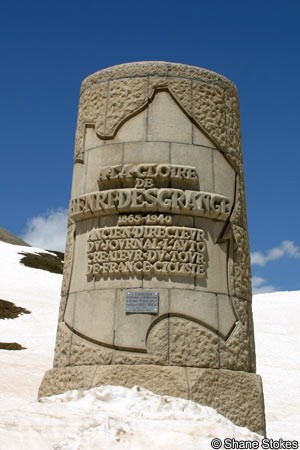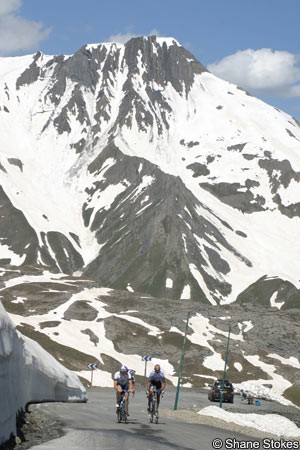
“Oh! Sappey! Oh! Laffrey! Oh! Col Bayard! Oh! Tourmalet!” wrote Tour de France founder Henri Desgrange after the Tour’s first crossing, “I do not fail in my duty in proclaiming that beside the Galibier you are pale and vulgar drinks: before this giant there is little more than to pull his cap and bow down low!”
Just as the 2010 Tour paid a special tribute to the centenary of the race’s crossing of the Pyrénées by featuring the range’s most mythical pass, the Col du Tourmalet twice, the 2011 route will do likewise for the hundredth anniversary of the race’s crossing the Alps. The Col du Galibier, Desgrange’s favourite climb of all, will be climbed twice, in successive stages; the difference between this route and last though is that the peloton will not be treated to a rest day in between.
Having introduced the Pyrénées in 1910 Desgrange and Alphonse Steinès, the man who’d convinced Desgrange that the Tourmalet was passable, decided to add the Alps, France’s other, even mightier mountain range to the race. The decision was as popular with the riders as the introduction of the Tourmalet the previous year; unlike that time though, when the legendary Octave Lapize pushed his bike over the summit, Émile Georget and two other riders actually managed to ride to the top.
The race leader and eventual winner of the 1911 race Gustave Garrigou, the third man over the top, did shout: “You are bandits!” at the organisers though. Like the Tourmalet, the Galibier became a common fixture in the Tour de France, and a stone memorial is erected to the Desgrange near the summit.
The col was slightly lower in those days though, at 2556m, with a tunnel taking the road over to the other side of the pass. The tunnel was closed in 2002 for maintenance, meaning that the way over the top via the new road took the summit up to the full 2645m.
 Since that first ascent the Tour has crossed the Galibier a further 56 times, including twice in the 1930 race but not including 1996 when the climb was cancelled due to snow, making it second only to the Tourmalet in popularity. Unlike the Tourmalet though, the scaling of the giant Galibier has often proved decisive in the overall race. Like its Pyrénéen counterpart the climb has always, until now, been on the way to a stage finish elsewhere – often a summit finish at Les Deux Alpes, La Plagne or Alpe d’Huez – but it has seen devastating and decisive attacks on the way from riders like Eugène Christophe, Henri Pélissier, Gino Bartali, Fausto Coppi, Charly Gaul and Eddy Merckx.
Since that first ascent the Tour has crossed the Galibier a further 56 times, including twice in the 1930 race but not including 1996 when the climb was cancelled due to snow, making it second only to the Tourmalet in popularity. Unlike the Tourmalet though, the scaling of the giant Galibier has often proved decisive in the overall race. Like its Pyrénéen counterpart the climb has always, until now, been on the way to a stage finish elsewhere – often a summit finish at Les Deux Alpes, La Plagne or Alpe d’Huez – but it has seen devastating and decisive attacks on the way from riders like Eugène Christophe, Henri Pélissier, Gino Bartali, Fausto Coppi, Charly Gaul and Eddy Merckx.
The most recent time that the Galibier has had a drastic affect on the overall classification was in the 1998 race. After an anonymous first week, Marco Pantani climbed his way back into overall contention in the Pyrénées with stage victory at the Plateau de Beille. On the stage to Grenoble to Les Deux Alpes the little Italian climber attacked race leader Jan Ullrich on the Galibier in the pouring rain; the freezing conditions, coupled with Ullrich’s failure to eat properly, saw the pirate take almost 9 minutes out of the German, giving him an unassailable race lead.
The first ascent of the great climb this year will be from the southern side, via the Col du Lautaret, with the stage finishing at the 2645m pass itself. Strangely the Galibier will not be the highest point of the stage as it will have climbed the 2744m Col Angel as it crosses the border from Italy; this means that the Souvenir Henri Desgrange, traditionally awarded at the race’s highest point, will not be decided on the Father of the Tour’s favourite climb.
Last year’s first crossing of the Tourmalet was just 72km into a 199.5km stage dominated by a successful breakaway, which virtually allowed the race favourites to take a day off. This time though, the uphill finish – the highest one on the race’s history – will give nobody the chance to do anything at any less than 100%; just as Henri Desgrange would expect.
The very next day, the peloton will find itself turning right around and scaling the giant climb once more; this time from the tougher northern side, which also takes in the Col du Télégraphe on the way. There are few details released as yet, but the route profile indicates that the race may only climb to the original 2556m height and follow the original tunnel. The stage will be short and sharp at just 109km but finish with the Alpine summit that every climber wants to win: Alpe d’Huez.